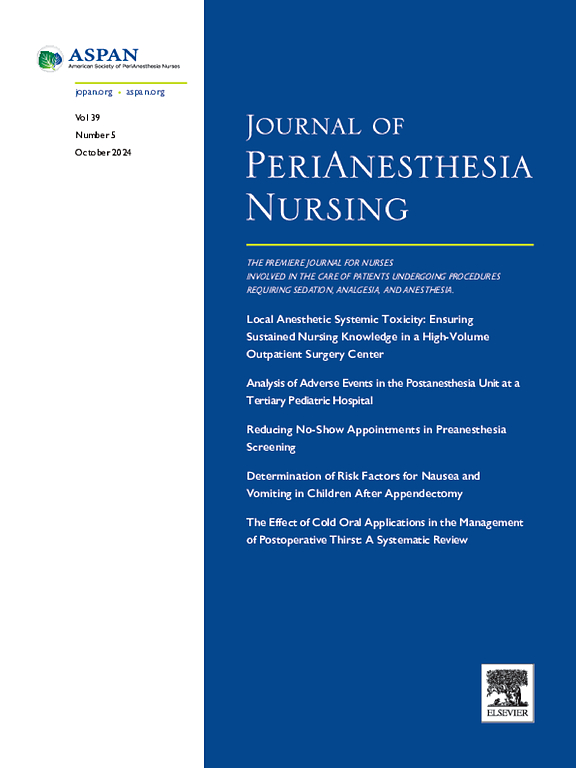一家中国三级儿童医院在全身麻醉下开展小儿眼科门诊手术的 5 年临床经验。
IF 2
4区 医学
Q2 NURSING
引用次数: 0
摘要
目的:非住院手术(当天或日间手术)是一种高效的医疗方法。然而,有关全身麻醉下儿童眼科非住院手术安全性的报道却很少。本研究旨在探讨其临床并发症:设计:回顾性观察研究:回顾性分析2015年1月至2019年12月在复旦大学附属儿童医院接受全身麻醉下非卧床眼科手术的小儿患者的临床资料。分析了术后并发症、非计划再次手术、延迟出院和其他不良事件:连续患者(N = 4,616)的平均年龄为(4.6 ± 2.6)岁。主要手术包括霰粒肿切开和刮除术(62.89%)、斜视手术(18.98%)、倒睫手术(14.36%)、眼睑或眼眶肿块切除术(2.49%)、睑外翻手术(0.91%)和其他手术(0.37%)。平均手术时间为(25.28 ± 20.45)分钟(n = 2,698),平均住院时间为(8.45 ± 2.61)小时。没有发生严重不良事件或死亡。1例术后延迟出血,1例术后感染,2例延迟出院。术后90天计划外再次手术率为0.39%,主要原因是霰粒肿复发和上睑下垂术后并发症:结论:全身麻醉下的小儿眼科门诊手术是一种可行且高效的手术模式,对于全身条件良好的简单手术而言,并发症较少。需要进一步开展随机对照研究,为这种模式的安全性和社会经济效益提供有力证据。本文章由计算机程序翻译,如有差异,请以英文原文为准。
A 5-Year Clinical Experience of Pediatric Ophthalmic Ambulatory Surgery Under General Anesthesia From a Chinese Tertiary Children's Hospital
Purpose
Ambulatory surgery (same-day or day surgery) is an efficient medical practice. However, there were few reports regarding the safety of ophthalmic ambulatory surgery for children under general anesthesia. This study aims to explore its clinical complications.
Design
A retrospective observational study.
Methods
The clinical data of pediatric patients who received ambulatory ophthalmic surgery under general anesthesia at the Children’s Hospital of Fudan University from January 2015 to December 2019 were analyzed retrospectively. Postoperative complications, unplanned reoperation, delayed discharge, and other adverse events were analyzed.
Findings
Consecutive patients (N = 4,616) had an average age of 4.6 ± 2.6 years. The primary surgical procedures included chalazion incision and curettage (62.89%), strabismus surgery (18.98%), trichiasis surgery (14.36%), eyelid or orbital mass resection (2.49%), blepharoptosis surgery (0.91%), and other procedures (0.37%). The average operative time was 25.28 ± 20.45 minutes (n = 2,698), while the average length of hospital stay was 8.45 ± 2.61 hours. No serious adverse events or death happened. One case had delayed postoperative hemorrhage, one had a postoperative infection, and two had delayed discharge. The rate of unplanned reoperation was 0.39% 90 days after surgery, with recurrence of chalazion and postoperative complications of ptosis as the primary reasons.
Conclusions
Pediatric ophthalmic ambulatory surgery under general anesthesia is a feasible and efficient operation mode with few complications for simple procedures with good general conditions. Further randomized controlled studies are needed to provide strong evidence of the safety and socioeconomic efficacy of this mode.
求助全文
通过发布文献求助,成功后即可免费获取论文全文。
去求助
来源期刊

Journal of Perianesthesia Nursing
NURSING-
CiteScore
2.20
自引率
17.60%
发文量
279
审稿时长
90 days
期刊介绍:
The Journal of PeriAnesthesia Nursing provides original, peer-reviewed research for a primary audience that includes nurses in perianesthesia settings, including ambulatory surgery, preadmission testing, postanesthesia care (Phases I and II), extended observation, and pain management. The Journal provides a forum for sharing professional knowledge and experience relating to management, ethics, legislation, research, and other aspects of perianesthesia nursing.
 求助内容:
求助内容: 应助结果提醒方式:
应助结果提醒方式:


